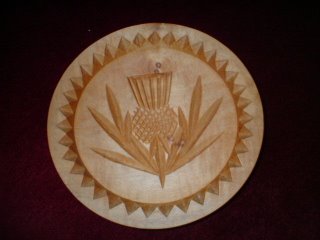
This week, one of the listings in my Ebay "Scottish Home" Shop, is a shortbread mould, carved with a thistle. I find that these little wooden pieces of Scottish kitchenalia are always very much in demand, although I'm never very sure whether people want them to use, or simply to decorate a rural kitchen.
Shortbread is one of those deceptively simple things that can turn out as variable as the people baking it. It was one of the first things we ever made at school, right after the 'fairy cakes' I seem to remember, but it was quite tricky. Essentially though, you need good butter, fine sugar (so called caster sugar) and plain white flour, not strong bread flour, which will give your finished shortbread too coarse a texture.
I can only remember recipes in ounces. but shortbread works on proportions, ie 12 oz flour, 8 oz butter and 4 oz caster sugar. If you can use sugar which has been flavoured with a vanilla pod in the jar, so much the better.
You sift your flour into a bowl, with a good pinch of salt, and then rub in the butter until the mixture 'resembles fine breadcrumbs' as our teacher used to say! Gently stir in the sugar, and then (here's the tricky bit) carry on rubbing. You should find that the mixture gradually begins to come together, as the butter becomes softer, until - kneading it gently - you will find that you have a ball of dough. Set it aside in a cool place for a while, to firm up, before you try to roll it out, otherwise it will be a bit sticky. The trick to using the wooden shortbread mould is to roll out your shortbread quite thickly, flour your mould, and then gently lift the shortbread slab over the mould, and press it in, (You can do this with a floured rolling pin if you like) cutting off the residue round the edges with a knife, much as you would if you were making a pie. This remaining dough can be rolled out again to make more rounds. Our teacher used to tell us that shortbread was fatty, so the baking tray didn't need greasing, but if you aren't using a non-stick tray, it would do no harm to grease it a little. Prick the biscuits with a fork so that they don't bubble up during the cooking process, and if you like, you can also mark them with a sharp knife, into the little triangles known in Scotland as 'Petticoat Tails' because of their shape.
Of course you can make perfectly good shortbread without using a mould, but using biscuit cutters instead. The shortbread should be baked in a moderate to cool oven (180C or less)- you are not looking to brown it, but simply to crisp it, while keeping it a nice pale straw colour. Cooking time depends on thickness of the biscuit but can be anything up to 20 - 25 minutes. Chunky shortbread will take longer than thin biscuits, but all of them are lovely. You can also experiment with different flavourings - caraway seeds are one of my favourite traditional additions. The biscuits should be cooled on a wire tray - they will crisp up as they cool. And if you are making Petticoat Tails, the traditional way is to break the cooled shortbread into pieces by hand, rather than using a knife.
Shortbread rounds can be piled up with strawberries or Scottish raspberries and whipped cream, to make fruit 'shortcakes'. Thin biscuits are delicious with a variety of summer sweets, or just fresh fruit and good vanilla ice cream. One other use for shortbread dough at this time of year is for making a wonderful summer crumble. Stop just short of the point where the dough becomes a ball, ie 'coarse breadcrumbs' and sprinkle over stewed apricots or gooseberries, or a mixture of cooked cherries and raspberries, in an earthenware dish, with a little brown sugar on top. This pudding should be baked in a moderate oven until it is golden brown, and served with good old fashioned custard or (my favourite) Greek Yoghurt. Yum.
No comments:
Post a Comment